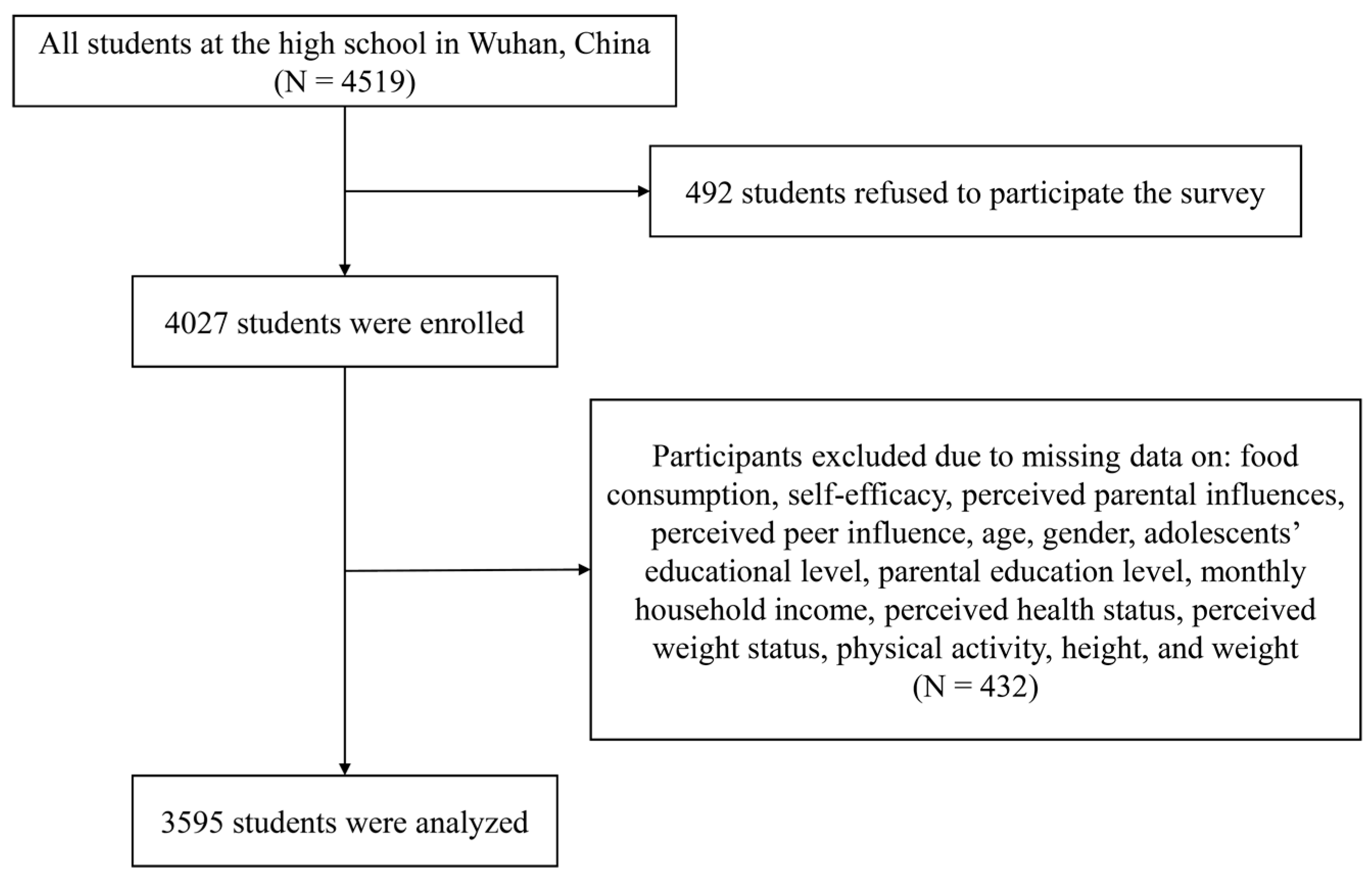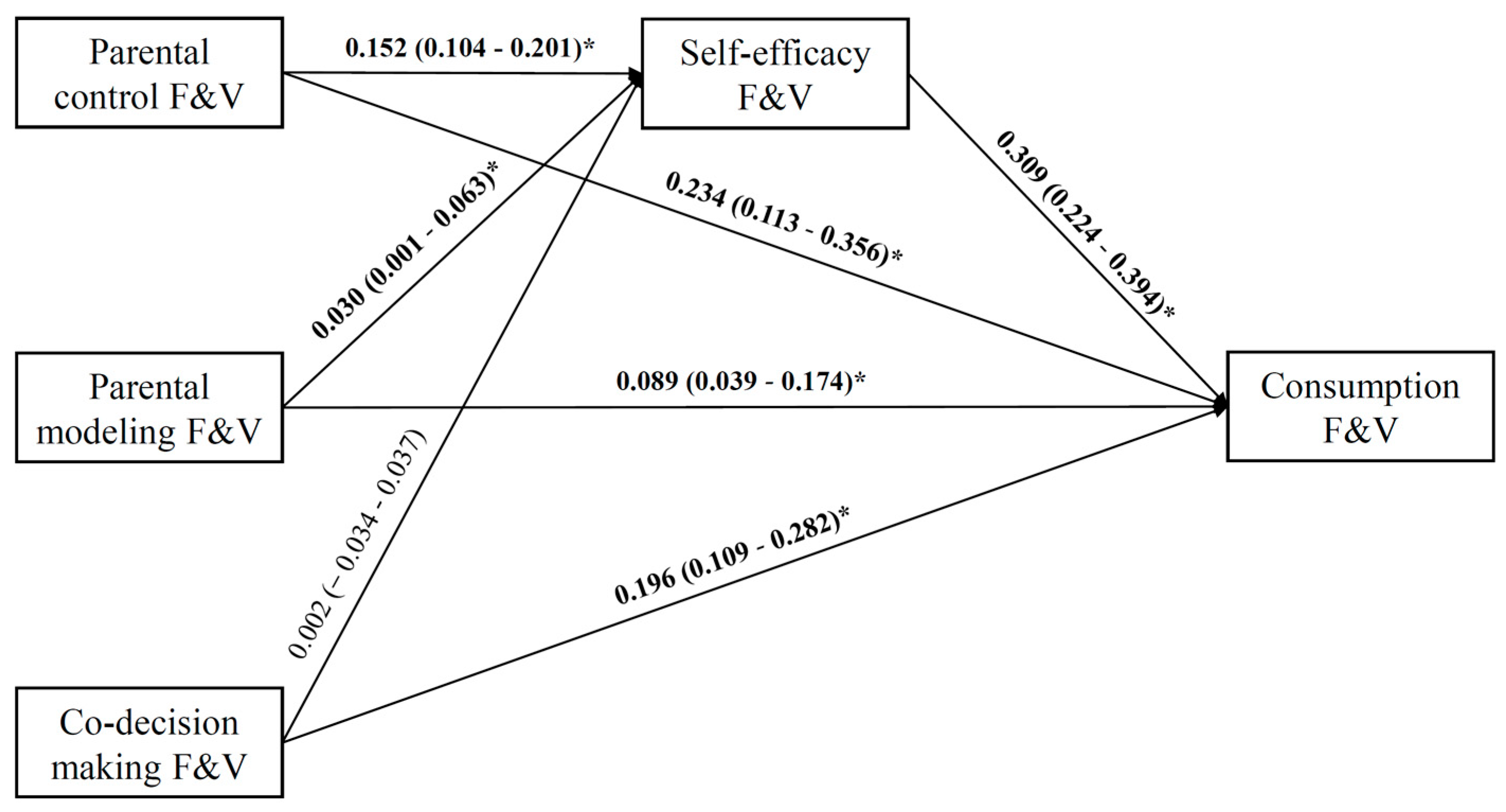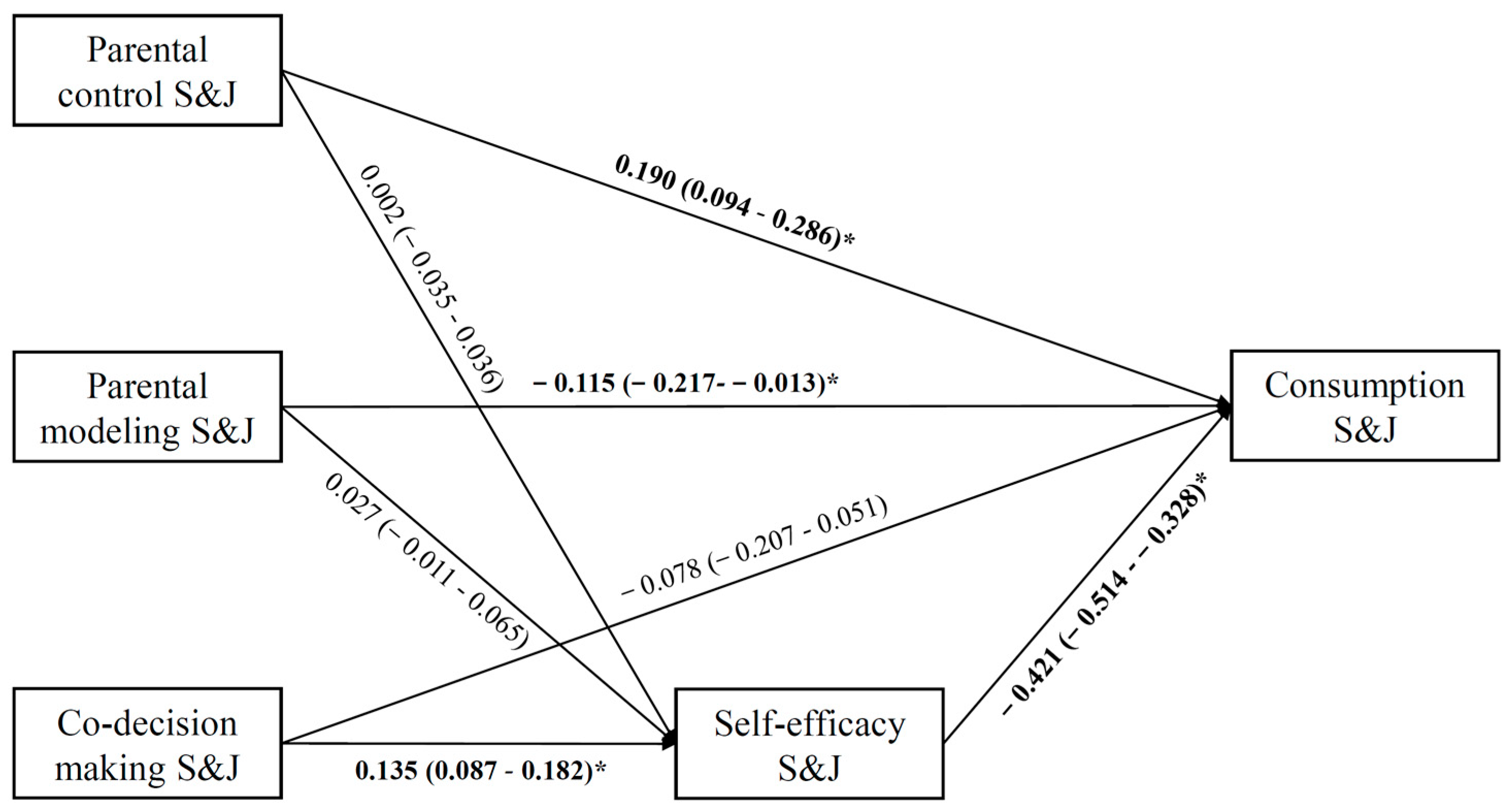Modeling Parental Influence on Food Consumption among Chinese Adolescents through Self-Efficacy: A Path Analysis
Abstract
1. Introduction
2. Methods
2.1. Ethics Statement
2.2. Participants
2.3. Measures
2.4. Statistical Analyses
3. Results
4. Discussion
5. Conclusions
Supplementary Materials
Author Contributions
Funding
Institutional Review Board Statement
Informed Consent Statement
Data Availability Statement
Acknowledgments
Conflicts of Interest
References
- O’neil, A.; Quirk, S.E.; Housden, S.; Brennan, S.L.; Williams, L.J.; Pasco, J.A.; Berk, M.; Jacka, F.N. Relationship between diet and mental health in children and adolescents: A systematic review. Am. J. Public Health 2014, 104, E31–E42. [Google Scholar] [CrossRef]
- Hojhabrimanesh, A.; Akhlaghi, M.; Rahmani, E.; Amanat, S.; Atefi, M.; Najafi, M.; Hashemzadeh, M.; Salehi, S.; Faghih, S. A Western dietary pattern is associated with higher blood pressure in Iranian adolescents. Eur. J. Nutr. 2017, 56, 399–408. [Google Scholar] [CrossRef] [PubMed]
- Lock, K.; Smith, R.D.; Dangour, A.D.; Keogh-Brown, M.; Pigatto, G.; Hawkes, C.; Fisberg, R.M.; Chalabi, Z. Chronic diseases: Chronic diseases and development 2: Health, agricultural, and economic effects of adoption of healthy diet recommendations. Lancet 2010, 376, 1699–1709. [Google Scholar] [CrossRef]
- Osei-Assibey, G.; Dick, S.; Macdiarmid, J.; Semple, S.; Reilly, J.J.; Ellaway, A.; Cowie, H.; McNeill, G. The influence of the food environment on overweight and obesity in young children: A systematic review. BMJ Open 2012, 2, 12. [Google Scholar] [CrossRef]
- Woo, H.D.; Kim, D.W.; Hong, Y.S.; Kim, Y.M.; Seo, J.H.; Choe, B.M.; Park, J.H.; Kang, J.W.; Yoo, J.H.; Chueh, H.W.; et al. Dietary patterns in children with attention deficit/hyperactivity disorder (ADHD). Nutrients 2014, 6, 1539–1553. [Google Scholar] [CrossRef]
- Lobstein, T.; Jackson-Leach, R.; Moodie, M.L.; Hall, K.D.; Gortmaker, S.L.; Swinburn, B.A.; James, W.P.T.; Wang, Y.; McPherson, K. Child and adolescent obesity: Part of a bigger picture. Lancet 2015, 385, 2510–2520. [Google Scholar] [CrossRef]
- Collese, T.S.; Nascimento-Ferreira, M.V.; de Moraes, A.C.F.; Rendo-Urteaga, T.; Bel-Serrat, S.; Moreno, L.A.; Carvalho, H.B. Role of fruits and vegetables in adolescent cardiovascular health: A systematic review. Nutr. Rev. 2017, 75, 339–349. [Google Scholar] [CrossRef]
- Jackson, T.; Chen, H. Risk factors for disordered eating during early and middle adolescence: A two year longitudinal study of mainland Chinese boys and girls. J. Abnorm. Child Psychol. 2014, 42, 791–802. [Google Scholar] [CrossRef] [PubMed]
- Thomas, J.J.; Lee, S.; Becker, A.E. Updates in the epidemiology of eating disorders in Asia and the Pacific. Curr. Opin. Psychiatry 2016, 29, 354–362. [Google Scholar] [CrossRef] [PubMed]
- Feng, T.T.; Abebe, D.S. Eating behaviour disorders among adolescents in a middle school in Dongfanghong, China. J. Eat. Disord. 2017, 5, 9. [Google Scholar] [CrossRef] [PubMed]
- Lallukka, T.; Laaksonen, M.; Rahkonen, O.; Roos, E.; Lahelma, E. Multiple socio-economic circumstances and healthy food habits. Eur. J. Clin. Nutr. 2007, 61, 701–710. [Google Scholar] [CrossRef]
- Cruwys, T.; Beyelander, K.E.; Hermans, R.C.J. Social modeling of eating: A review of when and why social influence affects food intake and choice. Appetite 2015, 86, 3–18. [Google Scholar] [CrossRef] [PubMed]
- Stead, M.; McDermott, L.; MacKintosh, A.M.; Adamson, A. Why healthy eating is bad for young people’s health: Identity, belonging and food. Soc. Sci. Med. 2011, 72, 1131–1139. [Google Scholar] [CrossRef] [PubMed]
- Bevelander, K.E.; Lichtwarck-Aschoff, A.; Anschütz, D.J.; Hermans, R.C.; Engels, R.C. Imitation of snack food intake among normal-weight and overweight children. Front. Psychol. 2013, 4, 7. [Google Scholar] [CrossRef] [PubMed]
- Pedersen, S.; Gronhoj, A.; Thogersen, J. Following family or friends. Social norms in adolescent healthy eating. Appetite 2015, 86, 54–60. [Google Scholar] [CrossRef]
- Sharps, M.; Higgs, S.; Blissett, J.; Nouwen, A.; Chechlacz, M.; Allen, H.A.; Robinson, E. Examining evidence for behavioural mimicry of parental eating by adolescent females. An observational study. Appetite 2015, 89, 56–61. [Google Scholar] [CrossRef][Green Version]
- Fitzgerald, A.; Heary, C.; Kelly, C.; Nixon, E.; Shevlin, M. Self-efficacy for healthy eating and peer support for unhealthy eating are associated with adolescents’ food intake patterns. Appetite 2013, 63, 48–58. [Google Scholar] [CrossRef]
- Robson, S.M.; Couch, S.C.; Peugh, J.L.; Glanz, K.; Zhou, C.; Sallis, J.F.; Saelens, B.E. Parent diet quality and energy intake are related to child diet quality and energy intake. J. Acad. Nutr. Diet. 2016, 116, 984–990. [Google Scholar] [CrossRef]
- Scaglioni, S.; De Cosmi, V.; Ciappolino, V.; Parazzini, F.; Brambilla, P.; Agostoni, C. Factors influencing children’s eating behaviours. Nutrients 2018, 10, 706. [Google Scholar] [CrossRef]
- Haidar, A.; Ranjit, N.; Saxton, D.; Hoelscher, D.M. Perceived parental and peer social support is associated with healthier diets in adolescents. J. Nutr. Educ. Behav. 2019, 51, 23–31. [Google Scholar] [CrossRef] [PubMed]
- Kelman, H. Compliance, identification, and internalization: Three processes of attitude change. J. Confl. Resolut. 1958, 2, 51–60. [Google Scholar] [CrossRef]
- Kelman, H.C. Interests, relationships, identities: Three central issues for individuals and groups in negotiating their social environment. Annu. Rev. Psychol. 2006, 57, 1–26. [Google Scholar] [CrossRef] [PubMed]
- Ma, Z.X.; Hample, D. Modeling parental influence on teenagers’ food consumption: An analysis using the family life, activity, sun, health, and eating (FLASHE) survey. J. Nutr. Educ. Behav. 2018, 50, 1005–1014. [Google Scholar] [CrossRef] [PubMed]
- Yee, A.Z.H.; Lwin, M.O.; Ho, S.S. The influence of parental practices on child promotive and preventive food consumption behaviors: A systematic review and meta-analysis. Int. J. Behav. Nutr. Phys. Act. 2017, 14, 14. [Google Scholar] [CrossRef]
- Ogden, J.; Reynolds, R.; Smith, A. Expanding the concept of parental control: A role for overt and covert control in children’s snacking behaviour? Appetite 2006, 47, 100–106. [Google Scholar] [CrossRef]
- Brown, K.A.; Ogden, J.; Vogele, C.; Gibson, E.L. The role of parental control practices in explaining children’s diet and BMI. Appetite 2008, 50, 252–259. [Google Scholar] [CrossRef] [PubMed]
- Vollmer, R.L.; Mobley, A.R. Parenting styles, feeding styles, and their influence on child obesogenic behaviors and body weight. A review. Appetite 2013, 71, 232–241. [Google Scholar] [CrossRef]
- Erskine, J.A.K. Resistance can be futile: Investigating behavioural rebound. Appetite 2008, 50, 415–421. [Google Scholar] [CrossRef]
- Ogden, J.; Coop, N.; Cousins, C.; Crump, R.; Field, L.; Hughes, S.; Woodger, N. Distraction, the desire to eat and food intake. Towards an expanded model of mindless eating. Appetite 2013, 62, 119–126. [Google Scholar] [CrossRef]
- Dickens, E.; Ogden, J. The role of parental control and modelling in predicting a child’s diet and relationship with food after they leave home. A prospective study. Appetite 2014, 76, 23–29. [Google Scholar] [CrossRef]
- Draxten, M.; Fulkerson, J.A.; Friend, S.; Flattum, C.F.; Schow, R. Parental role modeling of fruits and vegetables at meals and snacks is associated with children’s adequate consumption. Appetite 2014, 78, 1–7. [Google Scholar] [CrossRef]
- Peterson, G.W.; Rollins, B.C.; Thomas, D.L. Parental influence and adolescent conformity—Compliance and internalization. Youth Soc. 1985, 16, 397–420. [Google Scholar] [CrossRef]
- Reynolds, K.D.; Hinton, A.W.; Shewchuk, R.M.; Hickey, C.A. Social cognitive model of fruit and vegetable consumption in elementary school children. J. Nutr. Educ. 1999, 31, 23–30. [Google Scholar] [CrossRef]
- Young, E.M.; Fors, S.W.; Hayes, D.M. Associations between perceived parent behaviors and middle school student fruit and vegetable consumption. J. Nutr. Educ. Behav. 2004, 36, 2–12. [Google Scholar] [CrossRef]
- Cho, D.; Kim, S. Interplay between self-efficacy and perceived availability at home and in the school neighborhood on adolescents’ fruit and vegetable intake and energy-dense, low-nutrient food and sugary drink consumption. J. Nutr. Educ. Behav. 2018, 50, 856–867. [Google Scholar] [CrossRef]
- Saint-Maurice, P.F.; Welk, G.J. Web-based assessments of physical activity in youth: Considerations for design and scale calibration. J. Med. Internet Res. 2014, 16, 71–85. [Google Scholar] [CrossRef]
- Nebeling, L.C.; Hennessy, E.; Oh, A.Y.; Dwyer, L.A.; Patrick, H.; Blanck, H.M.; Perna, F.M.; Ferrer, R.A.; Yaroch, A.L. The FLASHE study: Survey development, dyadic perspectives, and participant characteristics. Am. J. Prev. Med. 2017, 52, 839–848. [Google Scholar] [CrossRef]
- Qiu, N.; Moore, J.B.; Wang, Y.; Fu, J.; Ding, K.; Li, R. Perceived parental attitudes are indirectly associated with consumption of junk foods and sugar-sweetened beverages among Chinese adolescents through home food environment and autonomous motivation: A path analysis. Nutrients 2021, 13, 3403. [Google Scholar] [CrossRef] [PubMed]
- Birch, L.L. Development of food preferences. Annu. Rev. Nutr. 1999, 19, 41–62. [Google Scholar] [CrossRef]
- Brown, R.; Ogden, J. Children’s eating attitudes and behaviour: A study of the modelling and control theories of parental influence. Health Educ. Res. 2004, 19, 261–271. [Google Scholar] [CrossRef]
- Daniels, S.R.; Hassink, S.G.; Comm, N. The role of the pediatrician in primary prevention of obesity. Pediatrics 2015, 136, E275–E292. [Google Scholar] [CrossRef]
- Brehm, S.S.; Brehm, J.W. Psychological reactance—A theory of freedom and control. Contemp. Psychol. 1982, 27, 935–936. [Google Scholar] [CrossRef]
- Bandura, A. Social cognitive theory: An agentic perspective. Annu. Rev. Psychol. 2001, 52, 1–26. [Google Scholar] [CrossRef] [PubMed]
- Herman, C.P.; Polivy, J. Normative influences on food intake. Physiol. Behav. 2005, 86, 762–772. [Google Scholar] [CrossRef] [PubMed]
- Ensaff, H.; Bunting, E.; O’Mahony, S. “That is his choice not mine!” Parents’ perspectives on providing a packed lunch for their children in primary school. J. Nutr. Educ. Behav. 2018, 50, 357–364. [Google Scholar] [CrossRef]
- Milligan, R.A.K.; Burke, V.; Beilin, L.J.; Richards, J.; Dunbar, D.; Spencer, M.; Balde, E.; Gracey, M.P. Health-related behaviours and psycho-social characteristics of 18 year-old Australians. Soc. Sci. Med. 1997, 45, 1549–1562. [Google Scholar] [CrossRef]
- World Health Organization. Chinese Adolescents Demographics. Available online: https://www.who.int/data/maternal-newborn-child-adolescent-ageing/adolescent-data (accessed on 1 October 2021).
- Higgs, S. Social norms and their influence on eating behaviours. Appetite 2015, 86, 38–44. [Google Scholar] [CrossRef]
- Robinson, E. Perceived social norms and eating behaviour: An evaluation of studies and future directions. Physiol. Behav. 2015, 152, 397–401. [Google Scholar] [CrossRef]
- Dong, F.; Howard, A.G.; Herring, A.H.; Thompson, A.L.; Adair, L.S.; Popkin, B.M.; Aiello, A.E.; Zhang, B.; Gordon-Larsen, P. Parent–child associations for changes in diet, screen time, and physical activity across two decades in modernizing China: China Health and Nutrition Survey 1991–2009. Int. J. Behav. Nutr. Phys. Act. 2016, 13, 11. [Google Scholar] [CrossRef] [PubMed]
- Lo, K.; Cheung, C.; Lee, A.; Keung, V. Associations between parental feeding styles and childhood eating habits: A survey of Hong Kong pre-school children. PLoS ONE 2015, 10, e0124753. [Google Scholar] [CrossRef]



| Characteristics 1 | ||
|---|---|---|
| Age, years | 14.67 | 1.73 |
| Gender, n (%) | ||
| Male | 1899 | 52.82 |
| Female | 1696 | 47.18 |
| Adolescents’ educational level, n (%) | ||
| Junior high school | 1632 | 45.40 |
| Senior high school | 1963 | 54.60 |
| Parental education level, n (%) | ||
| Illiterate or primary school | 232 | 6.45 |
| Middle school or high school | 2414 | 67.15 |
| College or above | 949 | 26.40 |
| Monthly household income, RMB | ||
| ≤5000 | 461 | 12.82 |
| 5000–10,000 | 1641 | 45.65 |
| 10,000–20,000 | 865 | 24.06 |
| 20,000–40,000 | 360 | 10.01 |
| ≥40,000 | 268 | 7.46 |
| Perceived health status, n (%) | ||
| Excellent | 467 | 12.99 |
| Very good | 743 | 20.67 |
| Good | 1439 | 40.03 |
| Fair | 850 | 23.64 |
| Poor | 96 | 2.67 |
| Perceived weight status, n (%) | ||
| Very underweight | 146 | 4.06 |
| A little underweight | 511 | 14.21 |
| Just right | 1058 | 29.43 |
| A little overweight | 1458 | 40.56 |
| Very overweight | 422 | 11.74 |
| BMI | 21.12 | 4.65 |
| MVPA per week (minutes) | 751.05 | 187.41 |
| Mean | SD | 1 | 2 | 3 | 4 | 5 | |
| 1. Parental control F&V | 3.69 | 0.92 | 1 | ||||
| 2. Parental modeling F&V | 3.55 | 1.15 | 0.45 * | 1 | |||
| 3. Parent–teen co-decision making F&V | 3.13 | 1.23 | 0.57 * | 0.39 * | 1 | ||
| 4. Self-efficacy F&V | 3.65 | 1.16 | 0.22 * | 0.14 * | 0.15 * | 1 | |
| 5. Consumption F&V | 3.51 | 2.69 | 0.23 * | 0.15 * | 0.20 * | 0.32 * | 1 |
| Mean | SD | 6 | 7 | 8 | 9 | 10 | |
| 6. Parental control S&J | 2.72 | 1.21 | 1 | ||||
| 7. Parental modeling S&J | 3.54 | 1.23 | 0.22 * | 1 | |||
| 8. Parent–teen co-decision making S&J | 3.28 | 1.02 | 0.34 * | 0.50 * | 1 | ||
| 9. Self-efficacy S&J | 3.45 | 1.22 | 0.48 * | 0.11 * | 0.15 * | 1 | |
| 10. Consumption S&J | 2.84 | 3.28 | 0.05 * | −0.10 * | −0.11 * | −0.24 * | 1 |
| Variable | b (SE) | 95% CI for b | p Value |
| Parental control F&V | 0.28 (0.06) | 0.16–0.40 | <0.001 |
| Parental modeling F&V | 0.10 (0.04) | 0.01–0.18 | 0.024 |
| Parent–teen co-decision making F&V | 0.20 (0.05) | 0.11–0.28 | <0.001 |
| Variable | b (SE) | 95% CI for b | p Value |
| Parental control S&J | 0.19 (0.05) | 0.10–0.29 | <0.001 |
| Parental modeling S&J | −0.12 (0.05) | −0.22–−0.01 | 0.026 |
| Parent–teen co-decision making S&J | −0.14 (0.07) | −0.28–−0.01 | 0.029 |
Publisher’s Note: MDPI stays neutral with regard to jurisdictional claims in published maps and institutional affiliations. |
© 2021 by the authors. Licensee MDPI, Basel, Switzerland. This article is an open access article distributed under the terms and conditions of the Creative Commons Attribution (CC BY) license (https://creativecommons.org/licenses/by/4.0/).
Share and Cite
Fu, J.; Liang, F.; Wang, Y.; Qiu, N.; Ding, K.; Zeng, J.; Moore, J.B.; Li, R. Modeling Parental Influence on Food Consumption among Chinese Adolescents through Self-Efficacy: A Path Analysis. Nutrients 2021, 13, 4454. https://doi.org/10.3390/nu13124454
Fu J, Liang F, Wang Y, Qiu N, Ding K, Zeng J, Moore JB, Li R. Modeling Parental Influence on Food Consumption among Chinese Adolescents through Self-Efficacy: A Path Analysis. Nutrients. 2021; 13(12):4454. https://doi.org/10.3390/nu13124454
Chicago/Turabian StyleFu, Jialin, Fang Liang, Yechuang Wang, Nan Qiu, Kai Ding, Jing Zeng, Justin Brian Moore, and Rui Li. 2021. "Modeling Parental Influence on Food Consumption among Chinese Adolescents through Self-Efficacy: A Path Analysis" Nutrients 13, no. 12: 4454. https://doi.org/10.3390/nu13124454
APA StyleFu, J., Liang, F., Wang, Y., Qiu, N., Ding, K., Zeng, J., Moore, J. B., & Li, R. (2021). Modeling Parental Influence on Food Consumption among Chinese Adolescents through Self-Efficacy: A Path Analysis. Nutrients, 13(12), 4454. https://doi.org/10.3390/nu13124454








